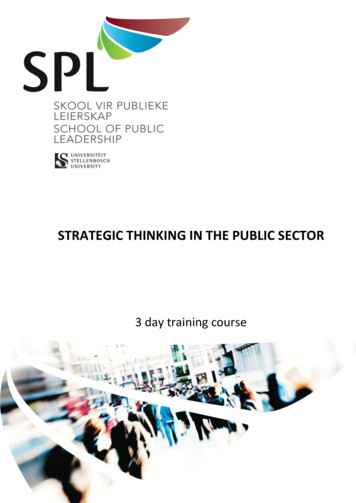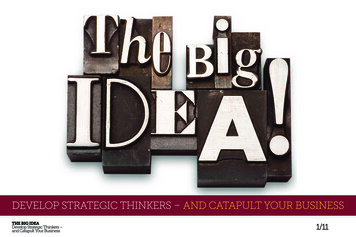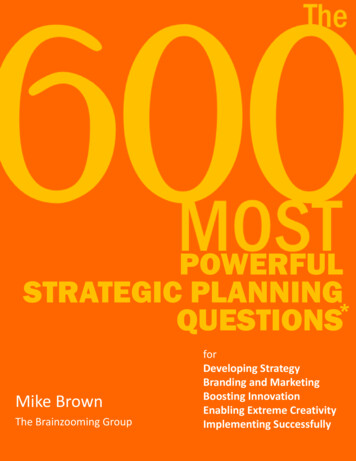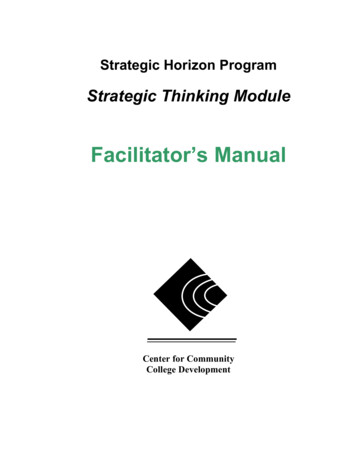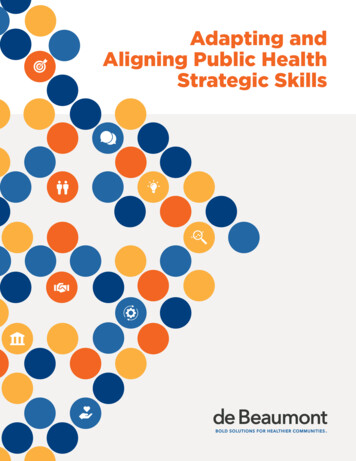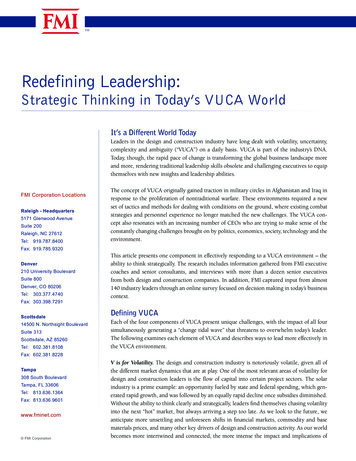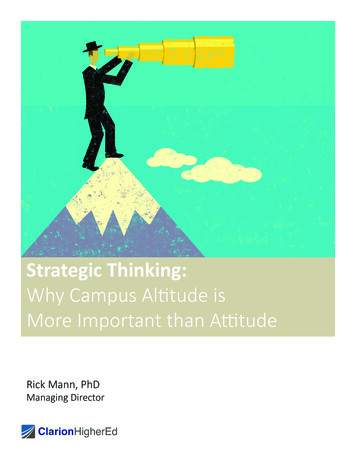
Transcription
Strategic Thinking:Why Campus Altitude isMore Important than AttitudeRick Mann, PhDManaging DirectorClarionHigherEd
ClarionHigherEdThis past year, I was involved in a research project with three other faculty members studyingthe views of nonprofit CEOs regarding whatis needed in the workplace. We surveyed 100nonprofit CEOs on the skills and traits neededfor success. They were first asked about theskills and traits that have led to their professional success as senior leaders. They reportedthat strategic thinking, communication skills,positivity, relationships, and leadership weremost important regarding their leadership.We followed up with additional questionsabout the skills and traits they were lookingfor in their employees. Again, strategic thinkingwas near the top of the list.In talking with college and university leaders,we hear the same things. Building the capacityof campus stakeholders to think strategically isconsistently a top concern particularly in thesedisruptive days of higher education.Strategic Thinking:Why Campus Altitude is More Important than Attitudetical and tactical employees. These are peoplewho work hard on the everyday practical thingsthat are on their desks. Many of these peoplecome early and leave late.Kate Beatty, author of Becoming a StrategicLeader: Your Role in Your Organization’s Enduring Success, also bears this out as she writes in“Statistics show that fewerthan 10% of leaders exhibitstrategic skills, a woefully inadequate number consideringthe demands on organizationstoday.”a Forbes (Feb 27, 2010) article, “Statistics showIn working with all types of organizations, we that fewer than 10% of leaders exhibit strategicconsistently see organizations filled with prac- skills, a woefully inadequate number considering the demands on organizations today. . . . Thejob of strategy is not limited to a few top execuTraits of CEO Successtives. Strategic leaders are needed throughoutour organizations if they are to adapt, innovate Strategic Thinkingand succeed well into the future.” Communication Skills PositivityStrategic Thinking RelationshipsStrategic thinking is at the core of strategicleadership and in today’s world, including higher education, it is in high demand. One of thecore concepts of strategic thinking is understanding strategic altitude. LeadershipTraits of New Employees Expertise Strategic Thinking Communication Skills Relationships Hard WorkStrategy expert, David Collis, writes in ThinkingStrategically, “When you think strategically,you lift your head above your day-to-day workand consider the larger environment in whichyou’re operating.” Having the ability and focusto lift our heads from our tactical work and lookat the broader horizon is key to understandingand engaging both strategic thinking and strategic altitude.2
Strategic Thinking:Why Campus Altitude is More Important than AttitudeClarionHigherEd“Can Do” AttitudeI realized the confusion between attitude andaltitude some years ago when I was servingas provost. It was at a summer cabinet meeting and our president had just unveiled t-shirtsthat had “Can Do” printed on them. We werebehind in our preparations for our fall schoolopening, and this was an attempt to get everyone engaged in the effort.In our cabinet discussions, we realized that ourlack of preparedness had to do with some strategic issues. Getting everyone to work longerand harder was at best a short-term solution.Time and time again I see leaders seeking toaddress strategic gaps with more tactical work.It is at this point, we need to clarity the conceptof strategic altitude. A “Can Do” attitude is typically engaging work at the tactical level. Tactical engagement is important, but it must beframed out in reference to both visionary andstrategic engagement.I was working with one academic administratorand we began to call this the “tactical tsunami.”A “tactical tsunami” is that overwhelming waveof work that seemingly presses in all around usall the time.A “tactical tsunami” is thatoverwhelming wave of workthat seemingly presses in allaround us all the time.While working with a senior team of IvyLeague-educated leaders on the East Coast, Iasked one of them how much time they spenteach month discussing strategic issues. Shesaid “none.” I pushed back in surprise and shesaid, “No, really! We spend every day focusedon nothing other than the tactical issues pilingup around us.”When we step back from these conversationsand reflect, we realize that there are higher altitude issues that are fundamentally differentAll of us have sat in meetings and asked our- than the on-the-ground tactical issues that fillselves if we are addressing the things that mat- our desks and days. We can look at the topic ofter most. These reflections get at the heart of altitude and consider a framework that includesstrategic altitude. Many times we come to re- three different and distinct levels. These levelsalize that the tactical, practical issues that are include visionary, strategic, and tactical levelspressing in on us are not the most important of engagement. Let’s unpack each of these togain more clarity on how they are different asissues which actually need our attention.well as how they related to one another.Visionary, Strategic, andTactical Levels of EngagementVisionaryStrategicTacticalVisionary Engagement: This is the highest levelof engagement and refers to core concepts ofwho we are as a college or university including mission, why do we exist, vision, where weare headed, and values, who are we. Visionaryengagement focuses on our aspirational future, that picture of our preferred future. It isinspirational and motivational. This level of engagement is the starting point of all that we dobecause mission, vision, and values are at thevery core of our institutions.3
ClarionHigherEdStrategic Thinking:Why Campus Altitude is More Important than AttitudeStrategic Engagement: If vision is about wherewe are headed, strategy is about deciding howwe are going to advance that vision. PresidentKennedy had a vision to reach the moon. NASAhad to develop a strategy to achieve that vision.Strategic choices include which road will wetake to reach our preferred destination? Whatare our mid-range strategic priorities? We haveto choose which metrics we will use as shortterm and long-term measures of progress. Withlimited resources, which initiatives will providethe most strategic return on investment? Greatstrategies give us greater confidence that ourvision can be realized.Tactical Engagement: As mentioned earlier,tactical engagement is about our everydaywork. That said, it takes on new importance aswe align our tactical work with our vision andstrategy. Tactical work becomes about executing and implementing our strategy by doing theright work well. High performing institutionshave a habit of doing the right things well.Visionary LevelAs mentioned above, we start with the visionary level which represents a perspective fromthe summit, has the longest horizon, and addresses the primary questions of: Why do we exist? This addresses the issuesof purpose and mission. Where are we headed? Here we focus onthe direction of the institution as well asthe aspirational vision or picture of a preferred future.leaders also have important role in remindingeveryone why we are here and why what weare doing is so important. Senior leaders incollaboration with other campus stakeholdersalso help point the way toward an aspirational direction and a picture of a preferred future.Leading at the visionary level with clarity, commitment, and collaboration is important forleaders across the institution. It inspires hopeand vitality.All three levels of engagement play a role inthe life of the institution. However, having not Who are we? This refers to the core values enough or too much of one level can lead toof the institution and its key stakeholder certain deficiencies. Here are the most comgroups.mon ways in which the visionary level gets outFrom a governance perspective, the board is of balance.ultimately responsible for affirming the mission When there is not enough visionary enof the institution. At a broader level of sharedgagement by leaders, people can becomegovernance, the stakeholders of the college anddisheartened or distracted.university speak into the vision and values ofthe institution. Then the president and senior When there is too much visionary engage-4
ClarionHigherEdStrategic Thinking:Why Campus Altitude is More Important than Attitudement, people can feel stuck in over-drive.In addressing the elements of mission, vision,and values of visionary engagement, here aresome principles to keep in mind: Clarity should not be assumed. Mission, vision, and values should be revisited every5-10 years to affirm the language and rolein the institution or to refresh and updatethe language for the next chapter. Communicating regularly the mission, vision, and values is key in keeping the institution focused on the highest levels of purpose, direction, and identity. Appropriate alignment is needed to keepall aspects of the college or university generally aligned with the high-level attributes of the institution.Strategic Level This mid-level altitude focuses on choosing thebest possible mix of strategic features to best advance the mission, vision, and values of theinstitution. Strategy is most often about choic es, focus, and discipline and can be describedas deciding “which.” The following list of choices begins at a high strategic level and works down to lower strategic levels.Which stakeholders will we serve andwhich value proposition(s) will we promiseand deliver for each stakeholder group?Which strategic priorities (usually 1-4) willwe choose for the next 3-5 years?Which strategies will we choose to advanceour chosen priorities?Which metrics will we choose to measureprogress on what matters most?Which initiatives will advance our strategy with the highest Return on Investment(ROI)?Institutions struggle when they lack focus anddiscipline at the strategic level and tend to fallinto one of two different traps: No focus: No one knows what choices havebeen made. Focus is too wide: When we choose 20 priorities, everything blends together.At this level, we can also miss the right balance. When there is not enough strategic engagement, vision does not translate intoresults or our tactical work does not alignwith our strategy and vision. When there is too much strategic engage-5
ClarionHigherEdStrategic Thinking:Why Campus Altitude is More Important than Attitudement, people lose sight of visionary aspiration or become preoccupied with just doingwork even if it is not aligned with the visionand strategy.Our research shows that of the three levels ofengagement, the strategic level is often theleast developed and least engaged by leadersand teams. With attention, focus, and development, the strategic level can be developed andleveraged.TacticalThis is the lowest level of engagement and focuses on getting on-the-ground, practical workdone. Sometimes it means doing the samethings we have always done. This can meananswering email, holding meetings, teachingclasses, managing budgets, etc. Of course, tactical work is what we do most hours of mostdays. The problem with an exclusively tacticalfocus is that we can lose the vision of whatwe are trying to accomplish. Also, we run intoproblems when most of our regular tacticalwork is not well-aligned with our strategicchoices. Lastly, a tactical focus can also limitchange. Change can refer to both process improvement or deciding what good things needto be discontinued in the pursuit of new inno-vation and/or new advances.At this tactical, practical, work level, the focus isoften on what, when, and whom: What needs to be done and at what levelof quality? When does it need be done? Who will do it?We never want to give the impression thattactical work is not important. As mentionedabove, we spend most of our hours doing tactical work. Instead, our goal is to find the relationship of the tactical level of engagement tovisionary and strategic levels.Here are some ways in which our tactical engagement can be out of balance. When there is not enough tactical engagement, our visionary and strategic levels ofengagement lose traction because of inadequate implementation and execution. When there is too much tactical engagement, 1) people can become weary because of the lack of vision, 2) people canbecome overworked, and 3) there can be alack of strategic results.6
ClarionHigherEdPractical Applications ofStrategic AltitudeThe applications of the concept of strategic altitude are many, both positively and negatively. When this framework can be leveraged effectively, the impact can be transformational.When things are not going well, these principles can also be helpful in describing what isworking and what is not.Raising the Altitudeof the DiscussionIt is common to be in a meeting or discussionand realize that the meeting’s focus is almostexclusively on tactical issues. At this point, itcan be invaluable to raise the altitude of theconversation from tactical issues to strategicissues. For example, I once had a senior leaderask me how much a certain position should bepaid. I answered by asking if we could begin bydiscussing some higher level issues related tohis questions. He agreed. We then moved to astrategic discussion about their philosophy ofcompensation and whether it was based onlongevity, credentials, performance, etc. Oftentactical issues are better addressed by startingat a higher strategic level. After framing out theissues at the strategic level, you can then seehow your tactical issues can be better aligned.Processing IssuesIn many cases we can use strategic altitude tohelp us in framing out processes. For example,if you and your team were processing the development of a new academic major, it can behelpful to begin with the mission, vision, andvalues of both the institution and the proposednew program. I will sometimes say, “Let’s beginby framing out this idea at a higher altitude andthen work down through the strategic and tactical elements.” This sequence can be invaluable in hitting the key issues at the right time.Strategic Thinking:Why Campus Altitude is More Important than AttitudeThe Altitude of MeetingsThe applications of strategic altitude to meetings are endless. Here I want to commend thework of Patrick Lencioni in his two books: Deathby Meeting and The Advantage. Death by Meeting is written in story form as is the case withmost of Lencioni’s books. The Advantage is alatter compilation of his many insights and heincludes a chapter on meetings. In this space,I will just highlight a few of the key points onhow meetings and altitude intersect.First, my higher education work and leadershipwas transformed by re-framing our meetingsinto separate visionary, strategic, and tacticalmeetings. Like many teams, as provost andpresident, I had sat through hundreds of hoursof meetings that had often intertwined all threealtitudes of engagement in the same meeting.Lencioni helped our cabinet to use the following framework for our college meetings.Weekly Tactical Meetings — These are yourtypical operational meetings dealing with allthe ongoing issues of running an institution.Whenever a significant strategic issue came upin the middle of a tactical meeting, we tabledthat for our next monthly strategy meeting.Monthly Strategic Meetings — A once-amonth strategy meeting gives you an opportunity to deal with the larger, higher, more significant, long-range issues. You can pick a time slotlike the 3rd Thursday of the month or just picka date for the months ahead. If you can’t geta whole day, just take a half day or two hours.Here you can deal with your monthly strategyreview as well as big issues like retention, compensation, facilities, or personnel planning.After some years, we held a monthly strategyday for a full day. We soon called it the mostimportant day of the month.Visionary Meetings Each Year — These aremeetings that are held quarterly, each semester or at fixed times during the year. Thesemeetings may include just the senior team, the7
ClarionHigherEdboard, and/or the whole campus. Visionarymeetings are inspirational, aspirational, andoften relational. Here you remind one anotherwhy you do what you do and why it matters.You can also look at long-range issues 5, 10, oreven 25 years out including facilities, capitalcampaigns, and other large-scale issues.Re-framing Tactical meetings — Second, onceyou have your meeting pattern in place foreach of the three levels, you can also look athow you can re-frame tactical meetings. Theseare the regular meetings that we have all thetime. Instead of going for 60 minutes with a fullagenda of tactical issues, consider starting offthe meeting with even a minute or two at thevisionary level reminding people of why we dowhat we do, where we are headed at a highlevel, and/or talking about why we exist. Next,take 2-3 minutes and connect the tactical issues of the agenda to the higher strategic priorities and strategies of the institution. Then youare at a great place to go 45-50 minutes on thepractical issues of the agenda. Just before youclose, you might want to circle back and connect what you just discussed or decided withyour strategic and visionary levels.Strategic Thinking:Why Campus Altitude is More Important than AttitudeMore Thoughts onStrategic ThinkingLet’s close by circling back to strategic thinking.Strategic altitude is just one of many conceptsrelated to strategic thinking. Other topics include strategic capacity and strategic clarity.We want to leave you with the idea that strategic thinking is the new core competency needed by all leaders in higher education today.Plan A Free Strategy Dayon Your CampusThese days can provide an affordable way tobuild the strategic thinking of your cabinet,board, and/or campus teams. If you are interested in scheduling a strategy day on your campus with ClarionHigherEd, the first day is freeincluding no travel cost for the Clarion consultant to come to your campus. For more information, feel free to visit www.clarionhighed.com or click here for Free Strategy Day.8
Strategic Thinking Strategic thinking is at the core of strategic leadership and in today's world, including high - er education, it is in high demand. One of the core concepts of strategic thinking is under-standing strategic altitude. Strategy expert, David Collis, writes in Thinking Strategically, "When you think strategically,
